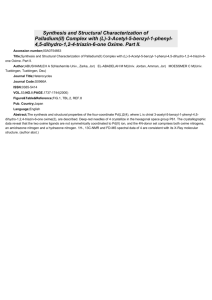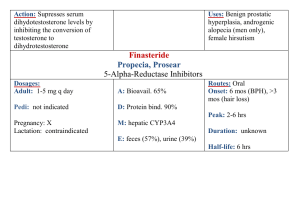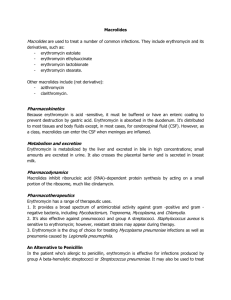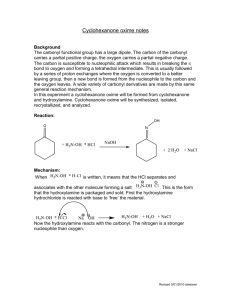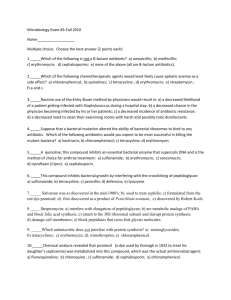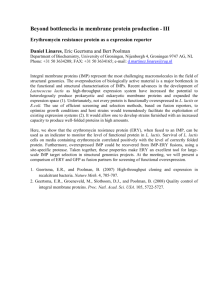Advance Journal of Food Science and Technology 5(1): 68-71,... ISSN: 2042-4868; e-ISSN: 2042-4876 © Maxwell Scientific Organization, 2013
advertisement
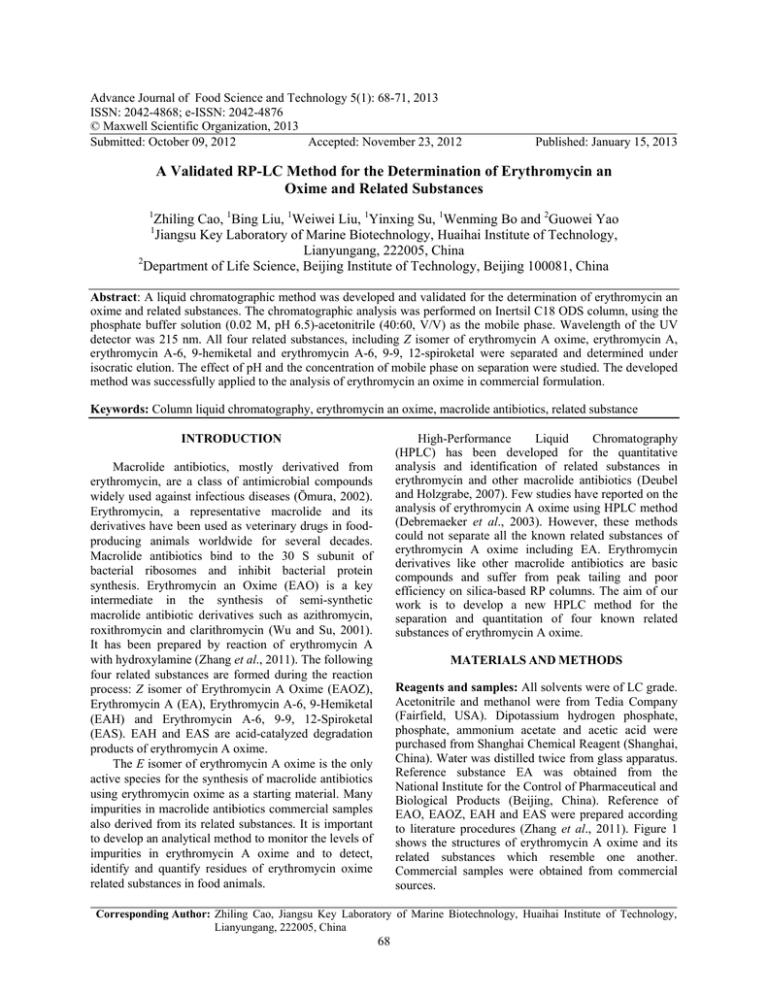
Advance Journal of Food Science and Technology 5(1): 68-71, 2013 ISSN: 2042-4868; e-ISSN: 2042-4876 © Maxwell Scientific Organization, 2013 Submitted: October 09, 2012 Accepted: November 23, 2012 Published: January 15, 2013 A Validated RP-LC Method for the Determination of Erythromycin an Oxime and Related Substances 1 Zhiling Cao, 1Bing Liu, 1Weiwei Liu, 1Yinxing Su, 1Wenming Bo and 2Guowei Yao Jiangsu Key Laboratory of Marine Biotechnology, Huaihai Institute of Technology, Lianyungang, 222005, China 2 Department of Life Science, Beijing Institute of Technology, Beijing 100081, China 1 Abstract: A liquid chromatographic method was developed and validated for the determination of erythromycin an oxime and related substances. The chromatographic analysis was performed on Inertsil C18 ODS column, using the phosphate buffer solution (0.02 M, pH 6.5)-acetonitrile (40:60, V/V) as the mobile phase. Wavelength of the UV detector was 215 nm. All four related substances, including Z isomer of erythromycin A oxime, erythromycin A, erythromycin A-6, 9-hemiketal and erythromycin A-6, 9-9, 12-spiroketal were separated and determined under isocratic elution. The effect of pH and the concentration of mobile phase on separation were studied. The developed method was successfully applied to the analysis of erythromycin an oxime in commercial formulation. Keywords: Column liquid chromatography, erythromycin an oxime, macrolide antibiotics, related substance High-Performance Liquid Chromatography (HPLC) has been developed for the quantitative analysis and identification of related substances in erythromycin and other macrolide antibiotics (Deubel and Holzgrabe, 2007). Few studies have reported on the analysis of erythromycin A oxime using HPLC method (Debremaeker et al., 2003). However, these methods could not separate all the known related substances of erythromycin A oxime including EA. Erythromycin derivatives like other macrolide antibiotics are basic compounds and suffer from peak tailing and poor efficiency on silica-based RP columns. The aim of our work is to develop a new HPLC method for the separation and quantitation of four known related substances of erythromycin A oxime. INTRODUCTION Macrolide antibiotics, mostly derivatived from erythromycin, are a class of antimicrobial compounds widely used against infectious diseases (Ōmura, 2002). Erythromycin, a representative macrolide and its derivatives have been used as veterinary drugs in foodproducing animals worldwide for several decades. Macrolide antibiotics bind to the 30 S subunit of bacterial ribosomes and inhibit bacterial protein synthesis. Erythromycin an Oxime (EAO) is a key intermediate in the synthesis of semi-synthetic macrolide antibiotic derivatives such as azithromycin, roxithromycin and clarithromycin (Wu and Su, 2001). It has been prepared by reaction of erythromycin A with hydroxylamine (Zhang et al., 2011). The following four related substances are formed during the reaction process: Z isomer of Erythromycin A Oxime (EAOZ), Erythromycin A (EA), Erythromycin A-6, 9-Hemiketal (EAH) and Erythromycin A-6, 9-9, 12-Spiroketal (EAS). EAH and EAS are acid-catalyzed degradation products of erythromycin A oxime. The E isomer of erythromycin A oxime is the only active species for the synthesis of macrolide antibiotics using erythromycin oxime as a starting material. Many impurities in macrolide antibiotics commercial samples also derived from its related substances. It is important to develop an analytical method to monitor the levels of impurities in erythromycin A oxime and to detect, identify and quantify residues of erythromycin oxime related substances in food animals. MATERIALS AND METHODS Reagents and samples: All solvents were of LC grade. Acetonitrile and methanol were from Tedia Company (Fairfield, USA). Dipotassium hydrogen phosphate, phosphate, ammonium acetate and acetic acid were purchased from Shanghai Chemical Reagent (Shanghai, China). Water was distilled twice from glass apparatus. Reference substance EA was obtained from the National Institute for the Control of Pharmaceutical and Biological Products (Beijing, China). Reference of EAO, EAOZ, EAH and EAS were prepared according to literature procedures (Zhang et al., 2011). Figure 1 shows the structures of erythromycin A oxime and its related substances which resemble one another. Commercial samples were obtained from commercial sources. Corresponding Author: Zhiling Cao, Jiangsu Key Laboratory of Marine Biotechnology, Huaihai Institute of Technology, Lianyungang, 222005, China 68 Adv. J. Food Sci. Technol., 5(1):68-71, 2013 OH HO N O HO OH O O 6 O O O O k O N OH HO O O O O 8 N OH HO OH 5 4 3 2 1 HO N OH OMe 4 OH OMe Erythromycin A oxime Z isomer of erythromycin A oxime O HO 2 OH O HO O O O OH O O O O HO O 6 pH 7 8 O O O 5 Fig. 2: Effects of mobile phase pH on the retention factor of EMO and relative substances on Inersil ODS C18 column Compounds: 1. EAOZ; 2. EA; 3. EAO; 4. EAS; 5. EAH Erythromycin A-6,9-hemiketal N HO O O 4 O O OH OMe OH OMe Erythromycin A HO O O O O N N OH HO During optimization of the HPLC process, the effect of mobile phase additives on retention behavior of erythromycin A oxime on common C18 columns was investigated. As shown in Fig. 2, the pH of the mobile phase is a major factor influencing the chromatographic behavior of erythromycin A oxime and its related substances. All five components were poor separated at pH below 5.5. An increase in the pH from 5.5 to 8.0 resulted in an increase in the retention factor (k). Improved separation and peak shape were also obtained by increasing the pH of the mobile phase. However, it was observed the peaks of EAO and EAS gradually eluted close to each other at a mobile phase pH above 7.0. Therefore we chose pH 6.5 for the mobile phase consisting of an acetonitrile-phosphate buffer. Although triethylamine and other organic bases were usually added in the mobile phase to improve peak shape of compounds with amino groups, they had no effect on resolution of erythromycin A oxime and the impurities. Previous studies have shown that end-capped C18 column might yield a better separation of the basic compounds than the non-end-capped ones used (Theodoridis et al., 1995). Thus, several reversed-phase columns packed with Inersil ODS, Kromasil C18 and Diamonsil C18, respectively, were tested using acetonitrile-buffer mobile phase. Comparing peak symmetry and separation efficiency, the Inersil ODS column provided the best results. Both methanol and acetonitrile was tested as the mobile phase organic modifiers and acetonitrile-water system gave better resolution than methanol-water system. Decreasing the percentage of acetonitrile in the mobile phase not only resulted in a slightly better separation between the four peaks (EAO, EAOZ, EAH and EAS), but also caused peak broadening and tailing of EA. To compromise the better resolution and faster analysis, we chose to use a mobile phase consisting of 0.02 M dipotassium hydrogen phosphate buffer (pH 6.5)-acetonitrile (60:40) for further testing. O OH OMe Erythromycin A-6,9-9,12-spiroketal Fig. 1: Structures of erythromycin a oxime and its related substances Instrumentation and chromatographic conditions: The chromatographic system consisted of a pump (Shimaduz LC-10AT HPLC pump), a UV detector (Shimaduz SPD-10A) and a CTO-10Avp column oven. An analytical Inersil ODS C18 column (5 μm, 4.6×150 mm, ID×L) was used and kept at 35°C. Chromatographic separation was achieved with a mobile phase consisting of acetonitrile-0.02 M phosphate buffer, pH 6.5 (40:60, v/v), at a flow rate of 1.0 mL/min. The 0.02 M phosphate buffer (pH 6.5) was prepared by mixing 0.02 M dipotassium hydrogen phosphate and phosphoric acid. The UV detection wavelength was 215 nm. Sample preparation: All samples were dissolved in the mobile phase previously described. For identification purpose, a standard test mixture containing EAO (1.63 mg/mL), EAOZ (0.265 mg/mL), EA (0.71 mg/mL), EAH (0.161 mg/mL) and EAS (1.10 mg/mL) was prepared. The commercial sample solution containing EAO (2.0 mg/mL) was also prepared. RESULTS AND DISCUSSION Method development: Erythromycin and its derivatives are composed of a 14-membered lactone combined with a common amino sugar. The latter can lead to poor peak shape and poor quantization in HPLC with reversed-phase columns. In order to improve the efficiency of analysis of basic compounds, using hybrid inorganic/organic phases at high pH was described previously (Miguel and Barbas, 2003; Davies et al., 2008). 69 Adv. J. Food Sci. Technol., 5(1):68-71, 2013 values of Relative Standard Deviation (RSD) were below 1.5% for all analyses. 3 160 Volts 120 Sample analysis: The modified method was then applied to HPLC analysis of the commercial formulations of erythromycin A oxime. Quantitation was done by comparing sample peak areas with those obtained from an external standard curve. The results are summarized in Table 2. Erythromycin, the unreacted raw material, could be detected in all erythromycin A oxime samples. 80 40 1 2 5 4 0 0 5 Time (min) 10 CONCLUSION Fig. 3: Typical chromatogram of EAO and relative substances on Inersil ODS C18 column mobile phases Acetonitrile-0.02 M K2HPO4 pH 6.5 (40:60); UV detection at 215 nm; flow rate 1 mL/min Peaks: 1. EAOZ; 2. EA; 3. EAO; 4. EAS; 5. EAH A new HPLC method has been developed for the analysis of erythromycin A oxime. The method is accurate and suitable for the separation and determination of all known four related substances of erythromycin A oxime, including EA, within 10 min. The described HPLC procedure proved to be fast and reliable for quality control of erythromycin A oxime in commercial formulations. Table 1: Main validation parameters of erythromycin an oxime and the related substances Regression equation Y: Linear ranger peak area; C: Analyte (μg/mL) concentration, mg/mL r LOD (ng) EAOZ 26.5-265 0.999 24 Y = 9.897×105C+884 EA 71-710 0.992 25 Y = 3.457×105C+1189 0.999 15 EAO 163-1630 Y = 1.292×106C+544 EAS 110-1100 Y = 2.6930×105C-301 0.996 40 EAH 16-161 0.991 8 Y = 3.714×106C+2845 ACKNOWLEDGMENT We thank the Major Program for the Natural Science Research Foundation of the Jiangsu Higher Education Institutions (No. 10KJA170003); the Openend Founds of Jiangsu Key Laboratory of Marine Biotechnology, Huaihai Institute of Technology (No. 2011HS001). Table 2: The analytical results of erythromycin oxime samples (%) No EAOZ EA EAS EAH EAO 1 2.35 0.29 0.21 1.07 94.52 2 9.06 2.83 2.50 6.25 75.87 3 5.38 1.34 1.17 2.43 88.43 Macrolide compounds have only a weak UV absorbance in the low wavelength range (<220 nm) due to the lack a suitable chromophore. Therefore, UV detection at 215 nm was used to detect all analytes and had no significant interference with baseline and blank chromatograms. A typical chromatogram of the mixtures of reference standard erythromycin A oxime and the related substances is present in Fig. 3. Under the optimized HPLC conditions, all above components were cleanly separated within less than 10 min on an Inersil ODS C18 column (4.6×150 mm). REFERENCES Davies, N.H., M.R. Euerby and D.V. McCalley, 2008. Analysis of basic compounds by reversed-phase high-performance liquid chromatography using hybrid inorganic/organic phases at high pH. J. Chromatogr. A, 1178(1): 71-78. Debremaeker, D., D. Visky, H. Chepkwony, A. Van Schepdael, E. Roets and J. Hoogmartens, 2003. Analysis of unknown compounds in azithromycin bulk samples with liquid chromatography coupled to ion trap mass spectrometry. Rapid Commun. Mass Spectrom., 17(4): 342-350. Deubel, A. and U. Holzgrabe, 2007. Development of an enhanced separation of erythromycin and its related substances by liquid chromatography. J. Pharm. Biomed. Anal., 43(2): 493-498. Miguel, L. and C. Barbas, 2003. LC determination of impurities in azithromycin tablets. J. Pharm. Biomed. Anal., 33(2): 211-217. Ōmura, S., 2002. Macrolide Antibiotics Chemistry, Biology and Practice. 2nd Edn., Academic Press, New York. Method validation: Different validation parameters of this method are summarized in Table 1. The linearity of the method was determined in the range from 0.01 to 1.63 mg/mL with a 20 μL injection volume. The calibration plots show good linearity with correlation coefficients over 0.99 for all five analyses. The Limits of Detection (LOD), defined as signal-to-noise ratio of 3:1,were ranged from 8 to 25 ng for EAO, EAOZ, EAH and EA and about 40 ng for EAS. Repeatability of the HPLC analysis was tested by analyzing data from five injections of the same standard solution. The 70 Adv. J. Food Sci. Technol., 5(1):68-71, 2013 Theodoridis, G., I. Papadoyannis, A. HermansLokkerbol and R. Verpoorte, 1995. A study of the behaviour of some new column materials in the chromatographic analysis of Cinchona alkaloids. Chromatographia, 41(5): 153-160. Wu, Y.J. and W.G. Su, 2001. Recent developments on ketolides and macrolides. Curr. Med. Chem., 8(14): 1727-1758. Zhang, L., B. Jiao, X. Yang, L. Liu and S. Ma, 2011. Synthesis and antibacterial activity of new 4″-Ocarbamates of 11, 12-cyclic carbonate erythromycin A 6, 9-imino ether. J. Antibiotics, 64(3): 243-247. 71
